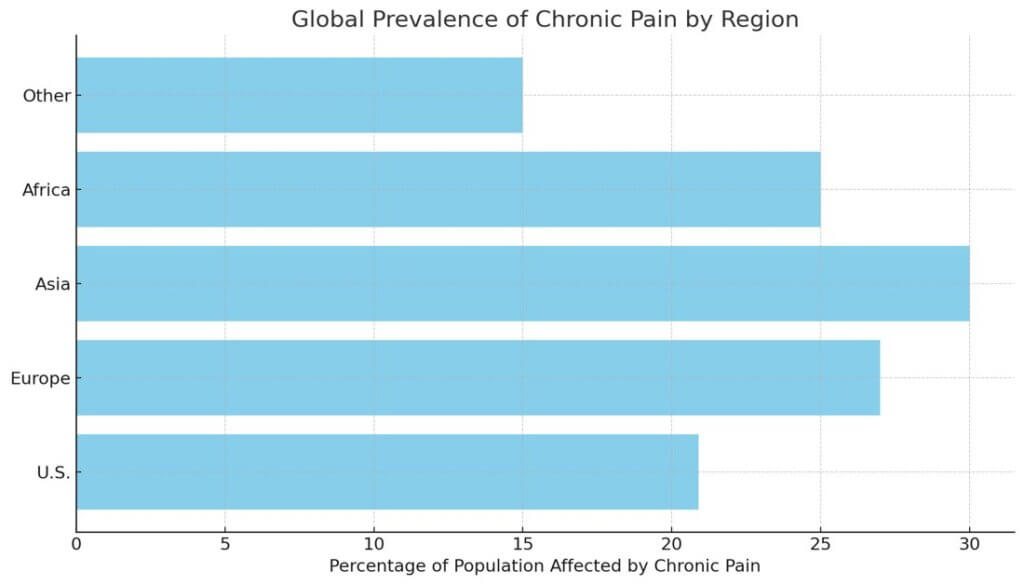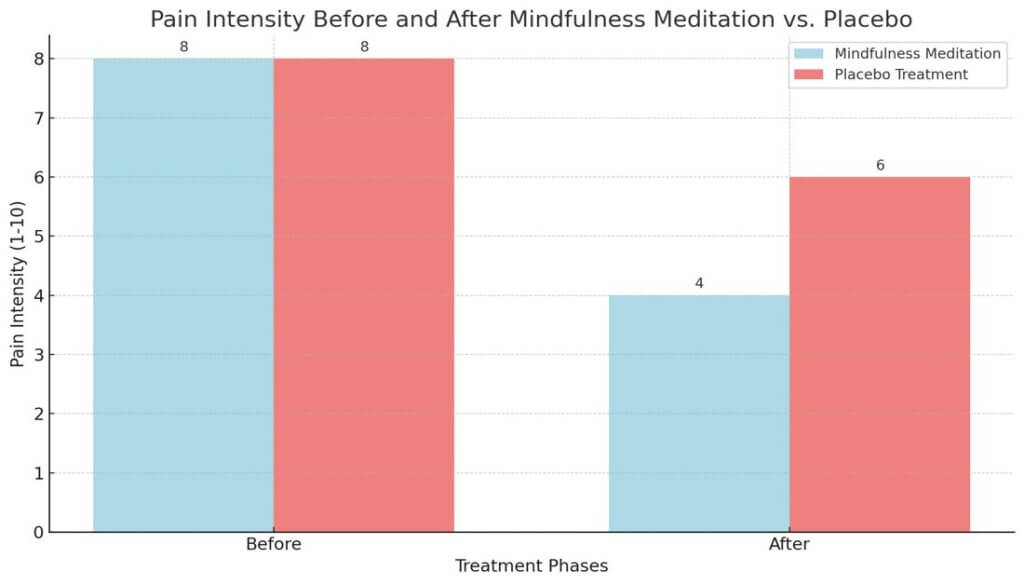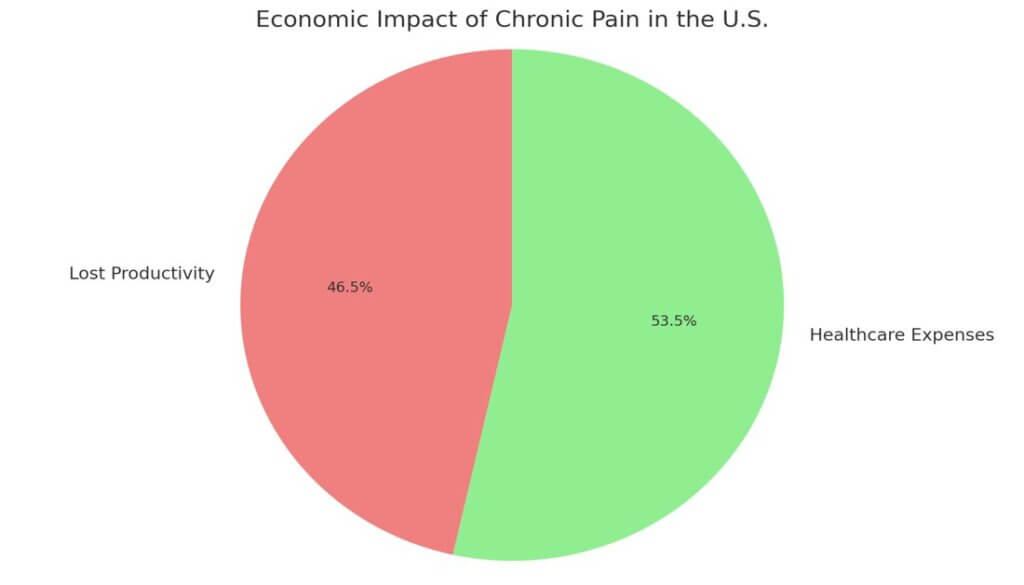Key Takeaways
1. Learn why 10% of the world’s population suffers from chronic pain and how meditation offers a powerful alternative to placebo treatments.
2. Discover how mindfulness meditation can reduce pain by half, without any medications or side effects.
3. Explore how meditation rewires the brain, reducing both pain intensity and emotional discomfort.
4. Understand how placebo treatments offer only temporary relief, while mindfulness provides a lasting solution.
5. See our before-and-after graph showing how mindfulness dramatically reduces pain compared to placebo treatments.
Chronic pain affects more people than heart disease, diabetes, and cancer combined. Around 780 million people globally are living with chronic pain, and in the U.S., 20.9% of adults suffer from some form of ongoing pain (The Good Body).
This widespread issue not only takes a physical and emotional toll on individuals but also impacts the economy, costing the U.S. between $299 and $344 billion annually in lost productivity (BioMed Central).
These numbers highlight a growing need for effective, non-drug treatments to manage pain.
One promising approach is mindfulness meditation, which recent research shows can reduce pain by directly influencing how the brain processes it.
Unlike placebo treatments, which rely on expectations, mindfulness meditation changes how we experience both the physical and emotional aspects of pain.
Let’s explore how mindfulness meditation works to provide real pain relief and why it stands out as a potential solution for millions of people suffering from chronic pain.
Global Prevalence Of Chronic Pain By Region

This bar chart shows the percentage of people affected by chronic pain in different regions. It highlights that regions like Asia and Europe have the highest prevalence rates, with 30% and 27% of the population experiencing chronic pain, respectively.
The U.S. also has a significant number, with 20.9% of adults suffering from chronic pain.
This global comparison illustrates the widespread impact of chronic pain across different populations.
What is the Placebo Effect?
The placebo effect happens when someone feels better after receiving a treatment that isn’t real. The treatment might be a sugar pill, cream, or even a fake surgery.
Even though there’s no medicine involved, people still feel improvement because they expect the treatment to help.
Let’s say a person has a headache, and they take a pill believing it’s a painkiller. Even if the pill contains no actual pain-relieving ingredients, the person might still feel better.
This is because their mind believes they’re receiving real treatment, and the brain reacts accordingly.
It’s a fascinating mind-body connection, but what if there’s a better way to manage pain than simply relying on belief?
Mindfulness Meditation: More Than Just a Placebo
For a long time, many people thought that mindfulness meditation helped manage pain by triggering the placebo effect.
This means they believed it worked because people expected it to, not because it had any real impact on the body or brain.
However, recent studies, including the one from UC San Diego, show that mindfulness meditation is much more powerful and works through completely different mechanisms than placebo treatments.
Unlike the placebo effect, which depends on belief or expectations, mindfulness meditation changes the way our brain processes pain directly.
When we practice mindfulness, we learn to focus on the present moment without reacting to pain emotionally.
This allows the brain to handle pain in a more neutral way, reducing both the intensity of the pain and the negative feelings associated with it.
The study found that mindfulness meditation reduces activity in the parts of the brain that deal with emotions and self-awareness.
This is key because when we are mindful, we stop associating pain with ourselves, which helps us experience pain without being overwhelmed by it.
This is different from placebo treatments, which simply work by creating expectations in the mind.
In short, mindfulness meditation doesn’t just make us think we feel better—it actually changes how our brain deals with pain.
This makes it a valuable tool for pain management, especially for those looking for non-drug methods to relieve chronic pain.
By practicing mindfulness, we can achieve real, lasting pain relief without depending on expectations or external treatments.
The Study: Comparing Mindfulness and Placebo for Pain Relief
The researchers conducted a study involving 115 healthy participants, who were randomly divided into four groups. Each group received one of the following interventions:
- Mindfulness meditation (guided meditation)
- Sham meditation (deep breathing)
- Placebo cream (petroleum jelly, which participants were told reduces pain)
- Audiobook control group
After applying a painful heat stimulus to the participants’ legs, the researchers used advanced brain imaging to observe how their brains responded to the pain both before and after the treatments.
The goal was to determine if mindfulness meditation activated different brain processes compared to placebo treatments.
The study revealed that mindfulness meditation not only reduced pain intensity but also altered brain activity in areas associated with emotional regulation and self-awareness.
The placebo cream mainly worked by influencing participants’ expectations but didn’t change how the brain processes pain as effectively as mindfulness did.
This finding suggests that mindfulness provides deeper and more lasting pain relief compared to placebo treatments.
Key Findings: How Mindfulness Reduces Pain
The study found that mindfulness meditation is far more effective than placebo treatments in reducing both the intensity and unpleasantness of pain.
When participants practiced mindfulness, they reported feeling less pain and less emotional discomfort.
This is because mindfulness works by altering specific brain patterns related to pain and negative emotions.
Mindfulness meditation targets areas of the brain responsible for self-awareness, emotional regulation, and introspection.
By focusing on the present moment without judgment, mindfulness helps separate the experience of pain from emotional reactions, making the pain feel less overwhelming.
It reduces activity in these brain regions, which leads to a decrease in how strongly pain is felt and how distressing it seems.
Take a look at the diagram below, which shows the before-and-after comparison of pain intensity for both mindfulness meditation and placebo treatments.

As the diagram illustrates, participants experienced a significant reduction in pain after mindfulness meditation (from 8 to 4), while the placebo treatment resulted in only a minor improvement (from 8 to 6).
In placebo treatments, like the placebo cream, pain was reduced mainly by influencing expectations.
The placebo effect made participants believe they would feel better, but it didn’t change the brain’s deeper pain-processing centers.
This demonstrates that mindfulness meditation is more than just a mental trick—it offers a real, biological way to relieve pain effectively.
Understanding the Brain’s Role in Pain Relief
The brain plays a central role in how we experience pain. When we feel pain, it’s not just a physical response to injury or discomfort.
The brain processes and interprets pain in multiple ways, involving emotions, expectations, and self-awareness.
In the study from UC San Diego, researchers focused on three key areas of the brain, called neural pain signatures, to better understand how mindfulness meditation and placebo treatments affect pain.
1. NAPS (Neural Activity Pain Signature): This part of the brain is linked to the emotional experience of pain.
It processes how pain makes us feel, such as whether it’s distressing or upsetting. When mindfulness meditation is practiced.
It helps reduce the emotional intensity of pain by calming this brain region. This means that even though the pain might still be there, it doesn’t feel as overwhelming.
2. SIIPS-1 (Stimulus-Independent Pain Signature): This area deals with our expectations of pain and other psychological factors.
The placebo effect primarily affects SIIPS-1 by making the brain believe the treatment will help, even if it doesn’t directly change how we experience pain.
Interestingly, mindfulness meditation doesn’t influence this area, proving it works through a different mechanism.
3. NPS (Neural Pain Signature): This is associated with the physical intensity of pain. It processes how strong or weak the pain feels in the body.
Mindfulness meditation alters this region, helping to reduce the sensation of physical pain, while placebo treatments have little to no impact on this part of the brain.
By targeting these specific brain areas, mindfulness meditation directly reduces both the physical and emotional aspects of pain, unlike placebo treatments which rely on expectation. This unique brain activity makes mindfulness a more effective, lasting approach to pain relief.
Why Mindfulness Meditation Works Better Than Placebo for Pain
Mindfulness meditation directly affects how the brain processes pain, making it more effective for pain relief than treatments that rely on expectations.
When practicing mindfulness, people focus on the present moment, acknowledging pain without reacting emotionally. This approach helps in reducing the emotional distress often linked to pain.
The practice works by targeting brain areas responsible for self-awareness and emotional regulation.
When these areas are activated, the brain learns to view pain as a neutral sensation, rather than something overwhelming or unbearable.
By calming these regions, mindfulness helps reduce both the intensity of the physical pain and the emotional discomfort that accompanies it.
This allows individuals to experience pain in a more manageable way, without becoming overwhelmed.
The unique aspect of mindfulness is that it creates a deeper change in the brain’s pain response.
This provides a more powerful and long-lasting relief from pain, making mindfulness a valuable tool for managing both short-term and chronic pain conditions.
The Importance of These Findings for Chronic Pain Management
Millions of people live with chronic pain every day. Many turn to medications, which can have side effects or become addictive. While the placebo effect can sometimes provide relief, it’s usually temporary.
This study suggests that mindfulness meditation can be a powerful, drug-free way to manage chronic pain.
By directly influencing the brain’s response to pain, mindfulness could improve the quality of life for countless people.
Chronic pain is not just a personal struggle—it also has a massive economic impact. In the United States alone, chronic pain costs up to $635 billion annually.
These expenses come from two main sources: lost productivity and healthcare costs.
To better understand the breakdown of these costs, take a look at the chart below, which highlights the economic toll of chronic pain on the U.S. economy.

It illustrates how much productivity is lost due to missed workdays and reduced efficiency, as well as the burden on healthcare systems.
However, more research is needed, especially with people who suffer from long-term chronic pain.
This study involved healthy participants, so scientists need to explore how mindfulness affects those with chronic conditions.
Looking Ahead: Future Research and Applications
The researchers believe this is just the beginning. As we learn more about how mindfulness changes the brain, new and accessible treatments could be developed.
These treatments would focus on helping people use mindfulness techniques to manage not just pain, but other health conditions as well.
According to Dr. Fadel Zeidan, one of the study’s lead researchers, “Millions of people are living with chronic pain every day.
And there may be more these people can do to reduce their pain and improve their quality of life than we previously understood.”
The future of pain management could very well include mindfulness meditation as a key tool.
Conclusion : Mindfulness Proven to Reduce Pain
In the end, this study shows that mindfulness meditation is much more than just a mental trick or placebo. It directly changes the way our brains handle pain, making it a powerful option for pain relief.
With no drugs involved, it offers a cost-effective, accessible way to manage both emotional and physical pain.
As more research comes in, we may see mindfulness becoming a widely-used tool in pain management clinics worldwide.
So, whether you’re dealing with pain now or just curious about new ways to cope in the future, mindfulness meditation is definitely worth exploring.
To read my other blogs: Click here
Sources: